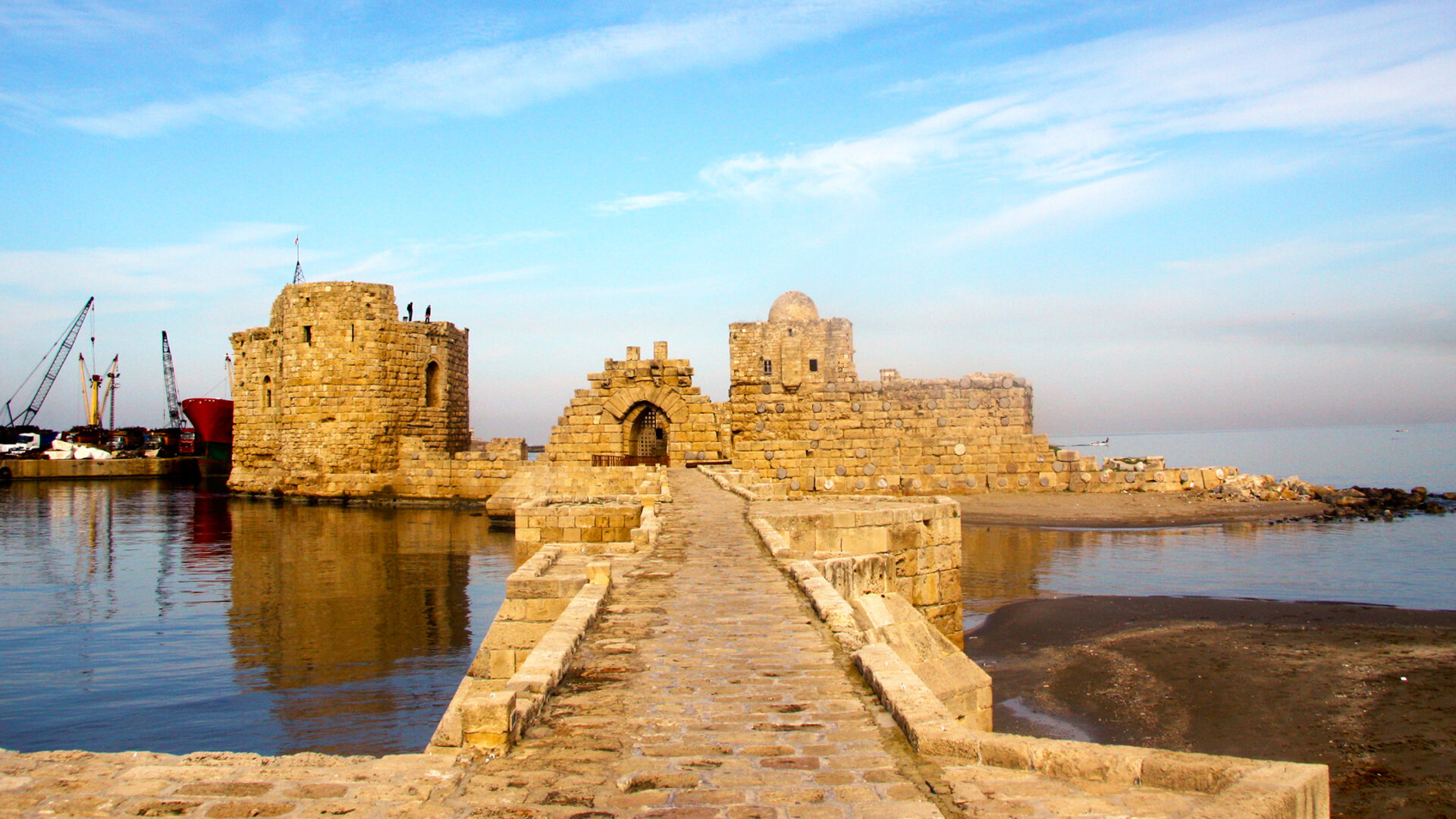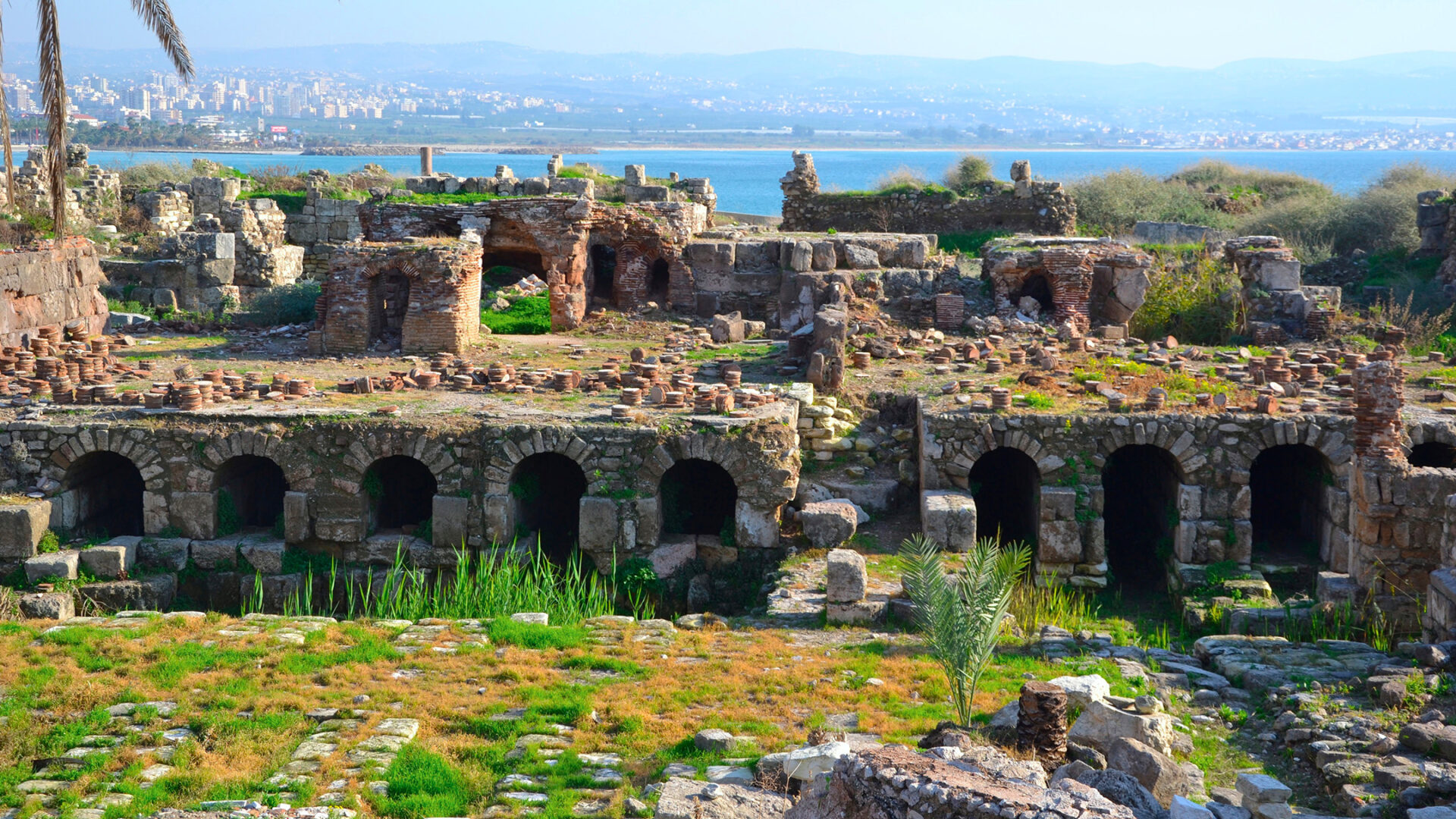The earliest recorded settlers of the land today called Lebanon were the Phoenicians, named so by the Greeks by virtue of the purple dye they extracted from Murex shells and sold across the Mediterranean. Organized in independent city-states, and spread along the Eastern Mediterranean coast, Phoenician civilization thrived between 1500 B.C. and 300 B.C., leaving behind the foundations of the great coastal cities of modern day Lebanon.
Although there remain almost no physical traces of this great civilization, the cities in which it thrived have survived to our times, and transformed through the ages from important trade centers to dense urban metropoles, bearing witness to the rich history that has shaped them.

Eshmoun and Saida
The trip begins by traveling south of Beirut towards Saida, or Sidon, one of the two most important city-states of the Phoenicians and their original seaport.
Just outside the entrance of modern Saida, close to the Awali river, lies one of the only remaining Phoenician sites in Lebanon, the temple of Eshmoun. Set in the expanse of lemon and orange orchards that border the city, the archeological site was discovered in 1900, and excavated from 1963 by French archeologist Maurice Dunand. Along with worship structures and water-related elements dedicated to the titular god of Sidon, Eshmoun, the Phoenician god of healing, the temple complex contained adjacent areas dedicated to goddess Astarte (Ashtart). Where some of the large parts of the temple are still visible on site, many artefacts, statues and smaller structures have been moved or looted, and some are today displayed in the National Museum in Beirut, and the Louvre in Paris. There also remain within the Eshmoun complex traces of later interventions, notably vestiges of a Roman villa, a colonnade and mosaics.
It is believed that another Phoenician temple, dedicated to the god Melkart, stood on the island that today holds the remains of Sidon’s Sea Castle. Driving south along the coastal road, the Sea Castle appears on the right, facing the entrance to Saida’s old souks. The Castle, initially built by the Crusaders in 1228, was destroyed and rebuilt multiple times by the Mamluks and later by Fakhreddine II in the 17th century. Beneath the island, buried vestiges, columns, walls and artefacts attest to the use of the island in Phoenician times. Inland, other important parts of ancient Sidon have been obliterated, ravaged by the modern city and construction, including the ancient Necropolis of Sidon, in which the important Alexander Sarcophagus was found (and today constitutes Istanbul’s Archeological Museum’s most prized possession), the St. Louis Castle (built by the Crusaders on a Fatimid ruin) and Murex Hill (the Phoenician mound of discarded Murex shells from which the legendary purple dye was extracted).

After the Castle visit, and perhaps some fresh fish for lunch, it is worth wandering inside the maze of the old souks, which contain a number of historic structures of various periods. Most notably, the soap museum, a restoration of a series of older soap manufacturing structures dating back to the 13th century, the Khan el Franj, built in the 17th century by Fakhreddine II, and one of the few remaining caravanserais in Lebanon, and the Debanne House Museum, a unique example of 18th century Ottoman architecture, all attest to Saida’s important past and enduring history. From the top of the Debanne palace, the view of Saida’s old city unfolds, revealing its Arab courtyard organization, and the expanse of the contemporary city beyond. You can also observe the Grand Omari Mosque, a 13th century example of Mamluk religious architecture, built on the remains of another Crusader fortress.
If you still have the energy, and the curiosity to visit a more recent vestige of the history of the city, a little drive inland towards Saida’s “hara” will lead you to a hidden garden, the British legions’ War Cemetery, which commemorates the British soldiers of World War I and II that fell in Saida.
It is now time to leave the dense urbanity of modern-day Sidon and retreat in Gladys’ orchards, a little south of the city on the road to Tyre.
Although there remain almost no physical traces of the Phoenician civilization, the cities in which it thrived have survived to our times.
Tyre, Sarafand and Naqoura
Start your second day by driving down the southern highway in the direction of Tyre. At the junction towards Nabatiyeh and Zahrani, rising on the hill on your left, the large cylindrical cisterns are remains of the American Trans-Arabian pipeline (Tapline), a major oil project of the 1940s that played a large role in the Middle East’s economic and political developments of the 1950s and 1960s.
Back along the coast, older histories unfurl, most notably in the town of Sarafand, the Phoenician port-city of Sarepta (Zarephath). Sarepta is exceptional amongst Phoenician cities in that the modern town of Sarafand which developed later did not lay on top of the Phoenician foundations. This allowed archeologists to excavate in 1963 ancient Sarepta extensively, yielding important Phoenician artefacts which today can be found in the National Museum in Beirut. Although nothing can be seen of the archeological sites today, important columns, sarcophagi, pottery workshops and kilns were found on the sea shore, along with a shrine to the goddess Tanit. Perhaps in continuance with the glass trade that flourished in Phoenician Sidon and Sarepta, today Sarafand holds the last remaining glass blowing factory in Lebanon, located in the center of the commercial coastal road. There you can visit the small factory and a shop selling some of the glassware produced.
Continuing along the coastal road soon you will find yourself driving along orchards of banana trees, along the large plain that precedes Tyre. The entrance of Tyre is defined by its history as an island, as the land suddenly jolts out into the sea. To the right the road extends into the old island part of Tyre, where the old port, Christian quarter and some of the sea-side ruins can be found. Straight ahead is the hinterland of Tyre, where the El Bass archeological site is located.
Before Alexander the Great’s conquest in 332 B.C, Tyre designated only the island part of the city, while the mainland was called Ushu. The island held two ports, which contributed to the importance of Tyre as a Phoenician trade center, surpassing the port of Sidon. The Sidonian port, on the northern side of the island, is the modern day port of the old town. The southern Egyptian port today extends into the mainland to form the beach reserve of Tyre. Below the northern port, a temple dedicated to Melkart, the titular god of Tyre, used to stand, presumably buried today underneath the modern day town.
The entrance of Tyre is defined by its history as an island, as the land suddenly jolts out into the sea.
Although Tyre bears no traces of this Phoenician past, it is rich in relics of its later history, and boasts incredible Roman, Byzantine and Crusader ruins. Inland, the archeological site of El Bass contains the largest Roman hippodrome ever discovered, as well as a Triumphal arch and an extensive necropolis. On the sea side, the large archeological site contains a sprawling complex of structures including a 2nd century colonnade and mosaic path, roman baths, a gymnasium, a rectangular amphitheater and water cisterns. Above the archeological site, across the road, the ruins of a 12th century crusader cathedral can also be visited.
After visiting the ruins, you can continue towards the old port area, and visit the renovated alleyways of the old town, lunch on fresh fish, and enjoy the sea breeze. In the afternoon, a short drive to the southern edge of Tyre will lead you to the public beach and its tents, or a little further down, to Tyre’s nature reserve, which contains wild flora spreading south along the coast.
If you chose to extend your trip, you can spend the night in Tyre, and head to Naqoura the next day, to wander in unspoilt beaches and white cliffs. Otherwise, it is time to return to Beirut, where perhaps other purple-tinted adventures await.